My First Pinball, OXO and My First Pinball Design, XOX
By Alan Norton
October 15, 2015
My First Pinball, OXO – Part 1 of 2
I played my first Williams OXO pinball machine while in high school in the mid 1970s. The Beechmont Mall was less than a mile away from home and across the street from school. It was only natural for a sixteen year old boy to find himself looking for the local arcade to discover the magical machines waiting inside. The Aladdin’s Castle I found there became my favorite place away from home. This was before the invasion of the video games, but there were other electromechanical arcade games in the front of the small arcade. For some reason, I didn’t look twice at any of these games. I was drawn to the pinball machines in the back, lining each side of the room.
I don’t remember the names of all of the pinball machines. There was a Gottlieb Jack in the Box and a Bally Amigo, later replaced with a Bally Rogo. I do remember vividly that a Williams OXO was on the left side in the middle of the row and a Williams Jubilee was somewhere nearby. Now, there are some games (Gottlieb) that will drive you, meaning me, crazy (Gottlieb) and Williams Jubilee was one of those games. The only skill shot was the captive ball horseshoe loop in the middle of the game. Get all five balls on one side and good things would follow. I never could shoot with enough skill to hit all of those balls onto one side. I’m not sure if any human could – although I know of one Jubilee owner who could be called “Master of the Horseshoe Loop.” He claims he can accomplish that task every other game or better, though I am somewhat dubious of those assertions.
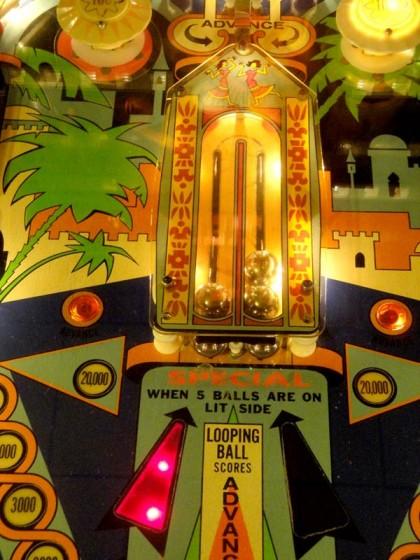
Williams 1973 “Jubilee” captive ball horseshoe loop
Image courtesy of Ryan Claytor of "Elephant Eater Comics"
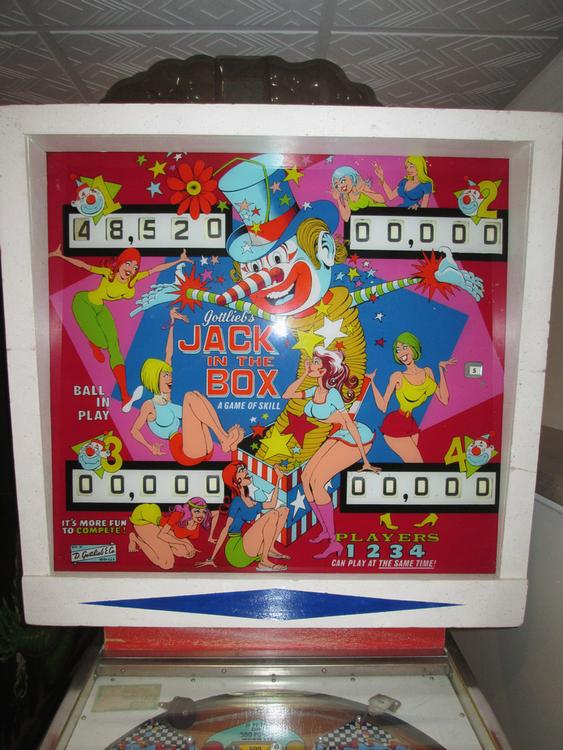
Gottlieb 1973 “Jack in the Box” - evil clown “Jack”
Image courtesy of Joseph “Tony” Dziedzic

Williams 1973 "OXO" full playfield
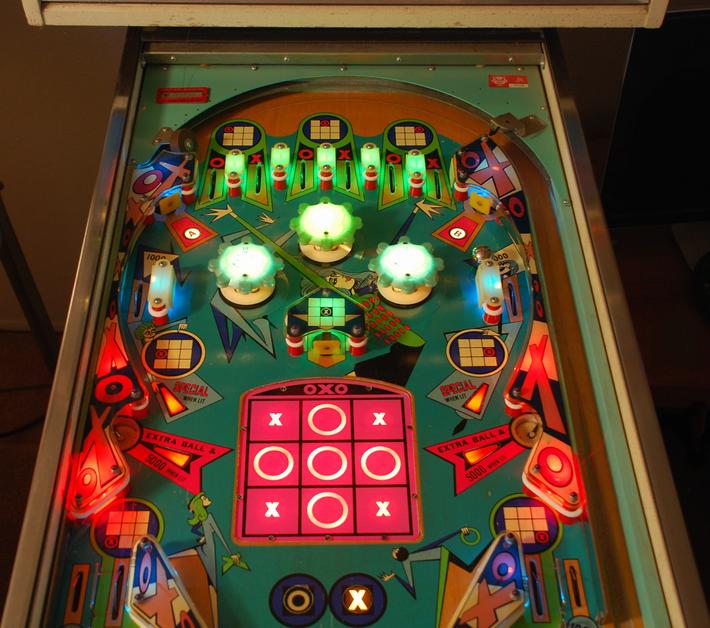
Williams 1973 "OXO" top playfield modified with green #47 lamps for inlanes and center plastic, and blue #47 lamps for side lanes
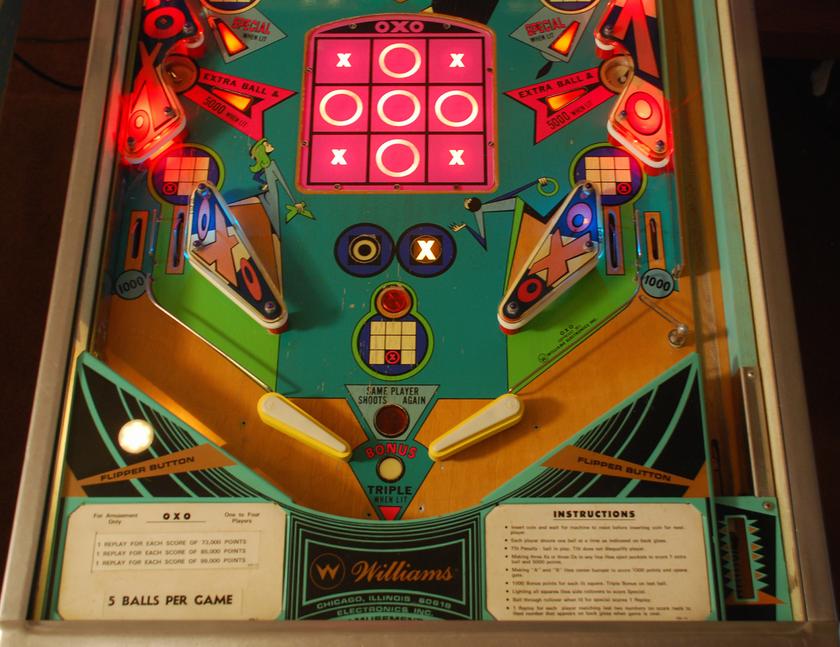
Williams 1973 "OXO" bottom playfield modified with red #47 lamps for kickout hole plastics and blue #47 lamps for slingshot plastics
Fast forward several years and I found myself in the prestigious halls of higher education. Of course I am referring to the passageways in the lower level of the University of Arizona Student Union. There, next to Louie’s Lower Level, a comfortable place to eat hot sandwiches and other comfort food fare, was an arcade to keep even the most ardent of pinball lovers busy. Most of the space was “wasted” on pool tables. There must have been a lot of pool sharks on campus because those felt tables were always busy. I was interested in a completely different kind of table – the kind that resides under glass and only had one steel ball and not 16 plastic balls!
The university farmed out the contract for the pinball machines to a private operator. When games broke, they would be called in as broken and fixed in a few days. What the operator did not do, ever, was to shop the machines with playfield cleaner, new wax and new rubber rings. These games were a gold mine for both university and operator. Half of them or more were in use at any given time. It wasn’t long before the playfields became hidden with a dark, ugly layer of “pinball dust.” Talk about your pinball pet peeves! Playing one of these games was like rolling in the mud with the pigs for someone like me who had been spoiled by the immaculate games at the Aladdin’s Castle.
So it was with excitement and hopeful anticipation when I entered a new arcade just west of the University of Arizona main gate called Fool Around. And there, about one third of the way down the row of pinballs was a Williams OXO! This soon became my new escape from reality and the rigors of learning. My senior year I was hired by Fool Around to be the “keeper of the keys.” Now, this was a very important position. The “keeper of the keys” was responsible for closing and locking the store but, more importantly, had access to all of the games. You couldn’t sneak free games of pinball while on the clock, but you could play free games with the girlfriend of the manager. Being around all of that fooling around was a lot of fun for a pinball lover like me.
And then it happened, like a stroke of lightning, a brilliant moment of pinball enlightenment, the idea that would change my pinball life forever. I don’t really remember the exact moment of pinball epiphany, but there it was. Why not buy OXO? I had first dibs. What could it hurt to ask? Fortune had smiled on me years earlier when I found a gold diamond ring. Selling a diamond ring for OXO seemed like the perfect plan. So, it was with a price and a gold diamond ring that I brought with me to a local gold and diamond buyer. Curiously, the $350 price of OXO and the remunerations from the ring were almost identical. It was destiny! OXO soon found its way into my second floor apartment. Pinball pleasure came with a heavy price though. I thought, at the time, that the diamond ring looked better on my girlfriend’s finger than in a drawer somewhere. I had to remove it from my girlfriend’s finger that was keeping it warm to buy OXO. Yeah, I was a real jerk to her and I'm not proud of that chapter in my life. I had the “flipper fever” bad! The good news, and there is always good news, was that the only direction was up from these lowly depths of relationship hell.
Living on the second floor of an apartment building and playing your very own OXO can lead to some curious issues – the kind that don’t make you all that popular with the residents below. There is a bank of 19 relays under the playfield that is reset with a 115 volt solenoid the size of a roll of half dollars. This monster solenoid has quite a kick to it and when engaged it pulls down the reset bar with a loud THUD! The flooring of the apartment only seemed to amplify the percussive sound. It was loud and it had to be annoying for those poor souls below awaiting the next pinball sonic boom. And happen it did, quite often, at the end of each ball. It’s just amazing what college students AKA party animals under the age of 21 can get away with.
I had lightly shopped OXO and it was looking and playing pretty good. In honor of the occasion, I invited over the Fool Around manager, Ziegfried, and his girlfriend, Madelyn, not their real names, to play OXO and show off my work. Madelyn, not her real name, said, paraphrasing, “Hon, don’t you think OXO would have gotten more use if it played like this.” Oops! Manager Sig-Oth, not a name at all, was not pleased with that comment. I was delighted.
My grandparents hauled OXO back to my parent’s house in Cincinnati after my senior year. We put it in the family room next to the front window. My brother and I played it and my mother enjoyed watching us. She even played a few games of OXO herself. My uncle was fascinated with all of the parts in the cabinet and under the playfield and attentively watched me replace the rod and ring on one of the pop bumpers. OXO was not just a family affair; my life-long friend Dave, his real honest-to-goodness name, also enjoyed playing OXO. He occasionally reminds me to this day of his trips down to my house and seeing those glowing neon colors of the backglass and the blinking lights behind the name “OXO.” It was a beautiful sight - even for those not appreciative of pinball.
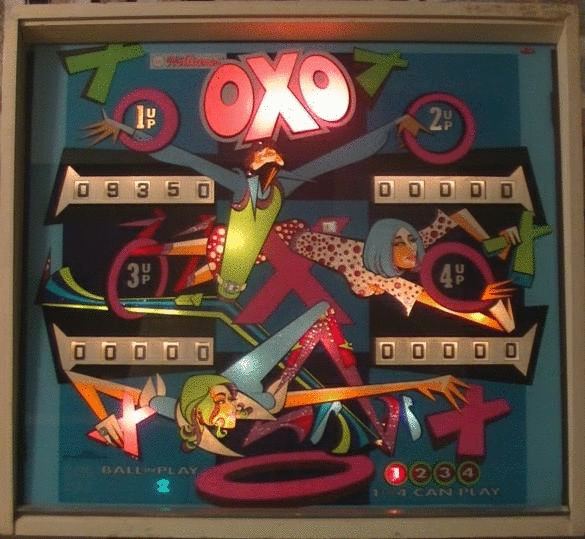
OXO did eventually make its way back to Tucson with me. I was working at Hughes Aircraft Company at the time and I met someone there who became interested in my small pinball collection. By this time I had acquired in addition to OXO and Expo a 1975 Williams Pat Hand. He particularly liked OXO, being the intelligent person that he was, and wanted a price. I had done quite a bit of work on OXO, though in retrospect the amount of work was small, and OXO felt like my machine. I didn’t want to let it go. He threw a wild price at me, $1,000. And so it happened that OXO was torn from my loving arms. It wasn’t long before he had the other two pins as well.
Perhaps it was for the best. I was busy learning the computer trade at Hughes. I don’t remember what triggered it but the “flipper fever” returned. So, it was sometime in the late ’80 or early ‘90s that I found my way to the local arcade games route operator to look at his discards. They had two Bally pins, Mr. and Mrs. Pac-Man and Hardbody. I wanted a Williams but took both Ballys for $1,100. Two Ballys in the hand are better than one Williams Fire in the burning bush. Well, maybe. I never fully appreciated Mr. and Mrs. Pac-Man but Hardbody made up for that. It had four flippers, two levels and real drop targets, a nice change from my Williams EMs that lacked all of the above. Both were solid state machines and both worked well enough that I only had to do a simple playfield shop with new bulbs, rubbers and wax. Many years later I tried to fire both up. The sound on Hardbody was no longer working and the upper playfield would, without warning, slide into the cabinet. Sadly, the machines continued to sit collecting dust for years, more than fifteen years in fact.
It was just a couple of years ago when my friend and I discussed the money that he owed me. I wanted the money but accepted OXO and Expo in exchange to wipe out the debt. He offered his Williams Pat Hand, but being one of my less favorite games, turned it down. I thought, incorrectly, that the values of the two pins were roughly equivalent to the debt. That was a mistake – I should have also taken Pat Hand in exchange especially since it was in the best shape of the three. There is still a possibility it will find its way back into Pecos’ Palatial Pinball Parlor.
So, I found myself with two of my favorite pinball machines returned to the fold once more. I was in no mood to play them anytime soon, however. Why not, you might ask? I have read that most Pinsiders have come to the consensus that every pinball owner must eventually learn how to shop and fix their own pins or hire someone to do it. Fine, I can agree with that sentiment but never underestimate the power of the human spirit to escape their pinball maintenance duties. This is how you separate the pinmen and pinwomen from the pinboys and pingirls. Both machines looked like they had never been cleaned and were in a state of filthy neglect. I was afraid to look at the mechanics knowing the condition of the playfield – that and of course the fact that the right flipper was dangling and pointing due south in OXO. I had seen worse. Yes it’s true; some pinball owners literally play their beloved pinball machines to death!
I now had four pinball machines collecting dust. I can tell you from experience that they are really good at that – especially in the desert! Now, who was the pinboy? Would my pins never receive my attention ever again? It would so happen that at some point in mid-2015 I found Pinside. A true pinball lover cannot read the forum at Pinside without the “flipper fever” setting back in. The Vid1900 playfield restoration thread caught my eye and I had the perfect candidate for a complete restore, my Williams Expo. I found and read Clay’s guides, very useful guides that I could easily understand.
Both Clay and Vid1900 gave me enough courage to begin the long restoration process. You can read the whole process here if you are interested or, just for giggles, to count how many mistakes I made in the process. My classic Williams EMs will, once again, be restored to their former glory and will, once again, be a joy to play! Playing a poorly maintained pin is a lot like eating green watermelon; it’s hard to stomach!
Fast rewind to July 1979. I needed one more class to get my degree at the University of Arizona. I was stuck in a studio apartment, by myself for the first time in my life in the heat of the summer Sonoran Desert. I don’t remember much about this time except that I passed my class and got my degree. I also remember the afternoon siesta to avoid the heat and humidity of the yearly monsoon. I thought in later years that the time was mostly wasted. That is until I remembered a pinball gem that I had apparently created during that very lonely summer period that I would like to share with you in the second part of this series.
My First Pinball Design, XOX – Part 2 of 2
OXO had always been and still is my favorite pinball. What more could an OXO lover do to pay homage to OXO but to create OXO, the sequel. I didn’t want to do an OXO II though, and this is somewhat scary, I had dreamed of several versions of OXO II. I decided instead on an expansion of the idea - keep the OXO theme and add the nemesis, XOX. I began to play around with the idea and finally put it down on paper. Below, you will find the original mock-up from July 14-26, 1979. If you look closely you might discover some features that were to become commonplace in later solid state pinball machines, none of which I had seen before.
First Mock-up
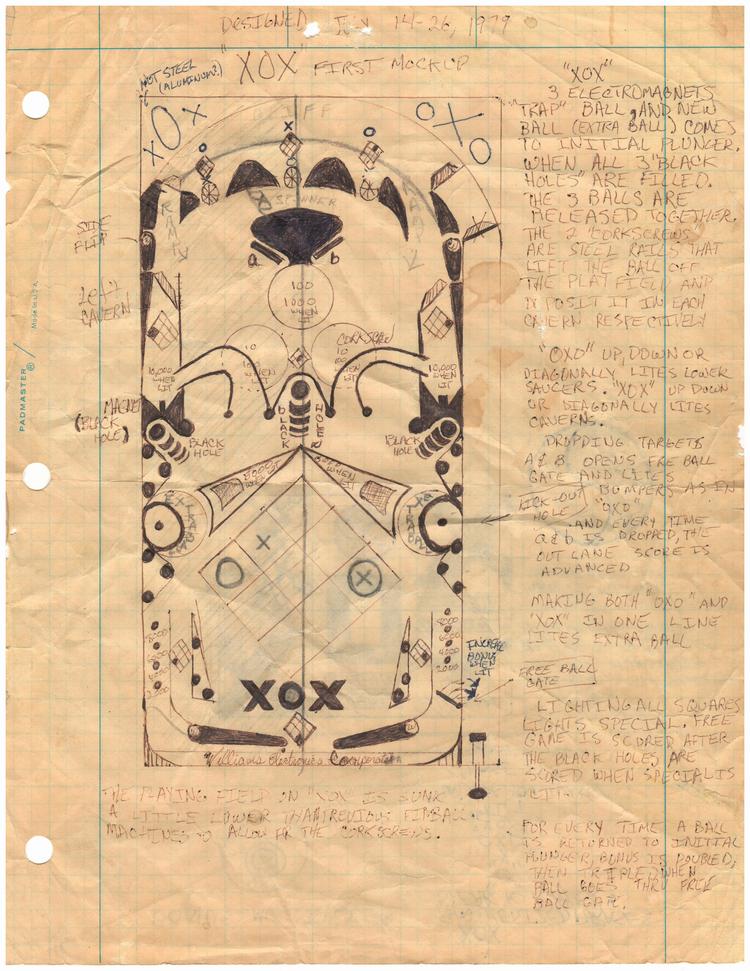
Original XOX playfield diagram from July 1979
All diagrams are not to scale and some features, like the flippers, are not properly oriented
- The left side of playfield is the XOX side and the art is predominately red.
- The right side of playfield is the OXO side and the art is predominately light blue.
- Playfield art in the center is yellow.
- The top of the playfield is ramped and the ball drops down speeding up in the process.
- Two ‘A’ and ‘B’ drop targets in the top-middle replace the two standup targets on OXO’s top left and right sides.
- There are three ‘Black Holes’ on both sides and center in the middle of the playfield. These are electromagnets that capture the pinball when it wanders nearby or when shot directly into the Black Hole.
- Two ‘Corkscrews’ are placed next the center Black Hole. The corkscrews are wire forms that direct the pinball off and over the playfield, twisting and turning the pinball into each of the two caverns on each side of the game.
- The caverns collect the points and then shoot the pinball straight up toward the upper playfield using kickbacks.
- The middle and bottom playfield is lowered enough to allow for the height of the two corkscrews.
- The XOX Abyss Kickback, when lit, returns the ball from the left outlane back onto the playfield.
- The OXO Abyss Gate, when open, returns the ball from the right outlane to the shooter lane.
- The OXO Star Gate, when open, returns the ball from the upper OXO playfield to the shooter lane when the right mini-flipper is lifted.
- Two mini-flippers above the kickbacks allow the player to redirect the pinball toward the top-center of the playfield to shoot at the ‘A’ and ‘B’ drop targets or the two spinners.
- On the "backglass" display there are metallic looking electronic displays on the XOX side and pseudo EM style score reels on the OXO side.
- The Tic-Tac-Toe Board is rotated forty five degrees from the OXO Board.
- Current letter in the “XOX” and “OXO” sequence is displayed on the backglass and playfield.
- Scoring is buffered allowing for two or more scores at the same time. Buffer is incremented upon scoring points and immediately decremented. Computer stops for a small fraction of a second when decrementing buffer. The result is that it might take a second or more for the score to catch up with the the points in the buffer. This adds more excitement and sense of accomplishment when hitting both spinners and when in multi-ball mode.
Second Mock-up
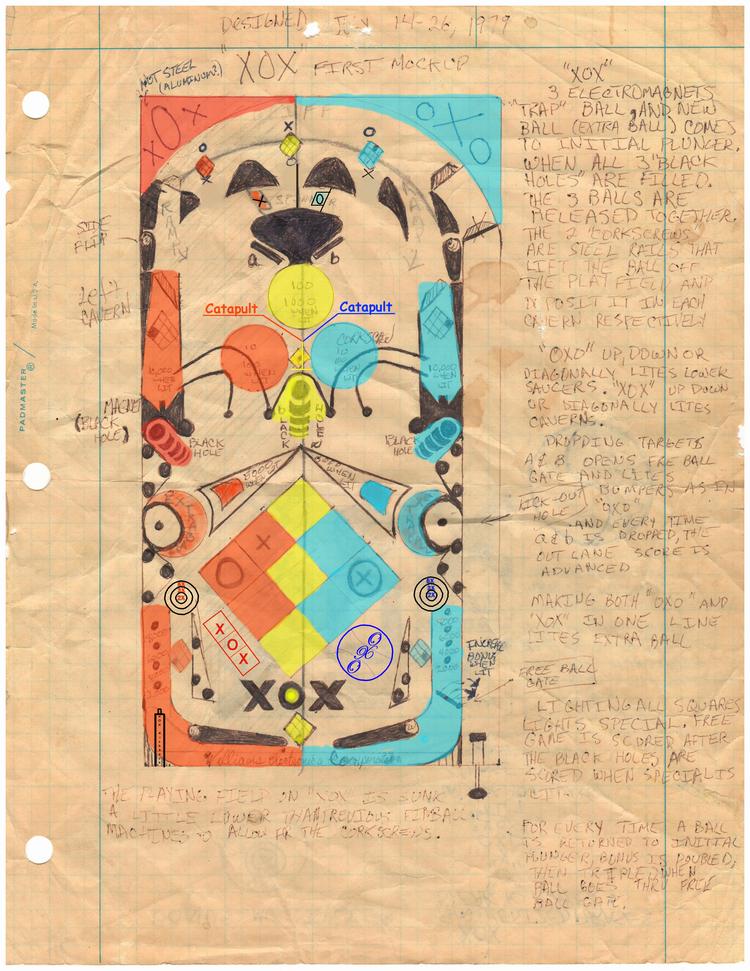
"XOX" playfield diagram
Modified August - October, 2015
Ruleset
I don’t really expect you, patient reader, to read through all of the rules listed below. OXO owners will be better able to make some sense of the rules. Everyone is invited to give feedback.
- Targets and Mini Tic-Tac-Toe Board rollovers score 1,000 points.
- Dropping ‘A’ target lights left XOX pop bumper increasing value from 10 to 100 points and lights XOX spinner increasing value from 100 to 1,000 points.
- Dropping ‘B’ target lights right OXO pop bumper increasing value from 10 to 100 points and lights OXO spinner increasing value from 100 to 1,000 points.
- Dropping both ‘A’ and ‘B’ targets light top middle pop bumper increasing value from 100 to 1,000 points.
- Dropping first the ‘A’ target and then the ‘B’ target activates XOX Abyss Kickback.
- Dropping first the ‘B’ target and then the ‘A’ target opens OXO Abyss Gate.
- Dropping first the ‘B’ target and then the ‘A’ target a second time opens the OXO Star Gate.
- ‘A’ and ‘B’ targets, XOX Abyss Kickback and OXO Abyss Gate all reset after being scored.
- There are 9 Mini Tic-Tac-Toe Board rollovers that score an ‘X’ or ‘O’ in each of the 9 squares.
- Both ‘X's and ‘O's can be scored in any square.
- Each ‘X’ and ‘O’ scores 1,000 bonus points.
- The three left Mini Tic-Tac-Toe Board rollovers on the XOX side correspond to the three left Tic-Tac-Toe Board squares. An ‘X’, ’O’ or ‘X’ is added depending on which letter is next in the “XOX” sequence. The pattern then starts over with a new “XOX” sequence.
- The three right Mini Tic-Tac-Toe Board rollovers on the OXO side correspond to the three right Tic-Tac-Toe Board squares. An ’O’, ‘X’ or ‘O’ is added depending on which letter is next in the “OXO” sequence. The pattern then starts over with a new “OXO” sequence.
- The three center Mini Tic-Tac-Toe Board rollovers correspond to the three center Tic-Tac-Toe Board squares. The value of the center three squares is determined by the following matrix:
| "XOX" Value | "OXO" Value | Center Square Value |
|---|---|---|
| X | O | X and O* |
| O | X | O and X* |
| X | X | X |
| O | O | O |
*Equivalent – scores both an 'X' and 'O' in the center square.
- The letter is advanced in the “XOX” sequence when any points are scored on the XOX side. The letter is advanced in the “OXO” sequence when any points are scored on the OXO side.
- Saucers score 500 points when not lit. “XXX” in a row lights the extra ball & 5,000 points for the XOX Saucer. “OOO” in a row lights the extra ball & 5,000 points for the OXO Saucer.
- Pinball in the XOX Saucer scores an extra ball & 5,000 points when lit.
- Pinball in the OXO Saucer scores an extra ball & 5,000 points when lit.
- Caverns score 1,000 when not lit. "XOX” in a row lights 10,000 points for the XOX Cavern. “OXO” in a row lights 10,000 points for the OXO Cavern.
- Pinball in the XOX Cavern scores 10,000 points when lit and releases ball in XOX Black Hole, if present.
- Pinball in the OXO Cavern scores 10,000 points when lit and releases ball in OXO Black Hole, if present.
- Catapult scores 1,000 when not lit. "XOX” and “OXO” in a row lights 10,000 points for the Catapult.
- Pinball in catapult when lit scores 10,000 and releases ball in Center Black Hole, if present.
- Black Holes score 5,000 points when ball is released.
- Pinball in XOX Cavern increases XOX outlane bonus. Pinball in OXO Cavern increases OXO outlane bonus. Bonus is increased from 2,000 to 4,000 to 6,000 to 8,000 each time the appropriate cavern kickback is activated.
- Activating the XOX Abyss Kickback and sending a ball through the XOX outlane increases the XOX bonus value from 1X to 2X to 3X to 5X.
- Opening and sending a ball through the OXO Abyss Gate increases the OXO bonus value from 1X to 2X to 3X to 5X.
- Bonus is received when ball reaches the outhole. Total bonus points are (1,000 for each ‘X ‘and ‘O’ + XOX outlane bonus + OXO outlane bonus) times (XOX bonus multiplier + OXO bonus multiplier). This sounds more complicated than it really is.
Example: The Tic-Tac-Toe board has 2 ‘X’s and 3 ‘O’s on it. The XOX bonus is 4,000. The OXO bonus is 6,000. The XOX bonus multiplier is 2X. The OXO bonus multiplier is 5X. The total bonus points equals: (2,000 + 3,000 + 4,000 + 6,000) x (2X + 5X) or
(15,000) x (7X) or
105,000 - Drop targets and all features are reset after each ball and at the start of a new game.
- One extra ball limit for each ball in play.
- Lighting all squares with ‘X’ or all squares with ‘O’ scores one special.
- Lighting all squares with ‘X’ and all squares with ‘O’ scores three specials, one when ‘X’ completed, one when ‘O’ completed and one when both completed.
Skill Shots
- Shoot the pinball with the mini-flippers toward the spinners or the 'A' and 'B' drop targets after being shot from the caverns.
- Shoot the Center Black Hole pinball when it is released or it will drain down the middle.
Problems
There are at least a couple of problems with the original design. There is a dead space between the two bottom pop bumpers. I have added a catapult there to fling the ball over the Center Black Hole and pseudo-randomly toward either flipper. Don’t ask me how it works or how it will look. I haven’t designed it yet. It will pose problems of its own. How do you direct the pinball either left or right? How do you fling a pinball over the Center Black Hole without it damaging the playfield?
The two mini-flippers can be raised when the pinball is shot from the caverns. This could potentially damage them. There are several solutions, a specially designed heavy duty mini flipper that can spring back when shot from below or deactivating the mini-flippers until the pinball is in a position to be hit or redirected to the shooter lane in the case of the right mini-flipper.
Backglass
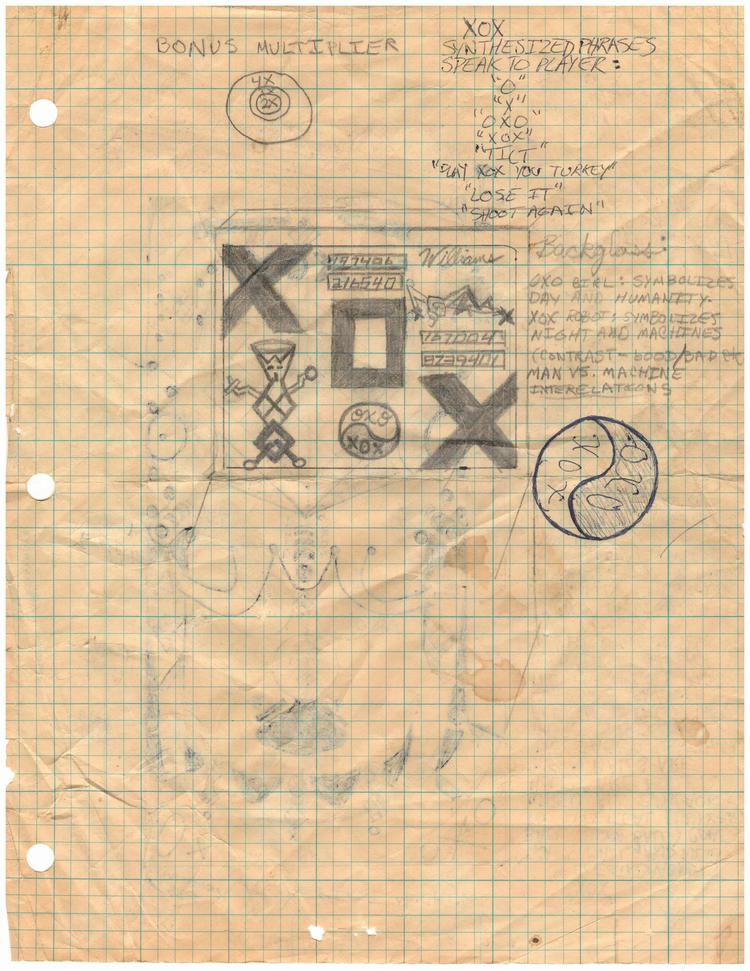
Original 'XOX' backglass diagram from July 1979
In order to score the three center squares of the Tic-Tac-Toe Board, robot and woman must work together – they are no longer separated. Man must work with machine to accomplish the pinball goals.
XOX Score Sheet
| Playfield Part | Count | Notes |
|---|---|---|
| Flippers | 2 x standard 2 x mini |
Heavy duty mini flippers |
| Flipper Buttons | 4 | |
| Pop Bumpers | 3 | |
| Slingshots | 2 | |
| Electromagnets | 3 | Capture, hold and release |
| Habitrail – Corkscrew | 2 | |
| Kickbacks | 3 | 1 Ea for caverns, 1 for left outlane |
| Drop Targets | 2 | |
| Spinners | 2 | |
| Electronic Score Displays | 2 | Red – Simulated on LCD |
| EM Style Score Reels | 2 | Light Blue - Simulated on LCD |
| Mini Tic-Tac-Toe Board Rollovers | 9 | 3 red, 3 yellow, 3 light blue – “painted” on playfield |
| Kickout Saucers | 2 | Off center holes |
| Catapult | 1 | Flings pinball over center black hole |
| Tic-Tac-Toe Board | 1 | In playfield |
| "XOX" sequence | 1 | In playfield |
| "OXO" sequence | 1 | In playfield |
Art Package
Pinball manufacturers have been trying for some time now to reduce cost of the art on the pinball machine. Take, for example, the attempt to replace backglass art with translites – a poor alternative in my humble opinion.
Like it or not, LC displays are the future for backglass displays. They can keep track of scores, play videos, change/customize the art and personalize the game. LCD panels and monitors are sharp enough to rival traditional backglass art and they don’t require incandescent, LED or other light sources.
Ideally, the artwork on the playfield could be projected by a mini projector that connects to a computer. But a projection would look unacceptable with current technology. There is, however, a simple solution that would also be cost effective. Playfield protectors made of Makrolon, or a similar thin polycarbonate, can be printed on the back with playfield art. The nice option with this kind of playfield art is that they can easily be easily removed and changed to an entirely different theme with an entirely different ruleset. Different themes on one pinball platform has been the holy grail of pinball manufacturers for years. This is what makes the virtual pin so popular. But unlike the “fake” look and feel of a virtual pin, a playfield protector with the artwork on it would keep the look and feel of the classic pinball machine.
The "plastics" art package will remain, but slightly modified for longevity and flexibility for theme changes. Thicker and stronger than normal clear plastic will be used eliminating the need for plastic protectors.
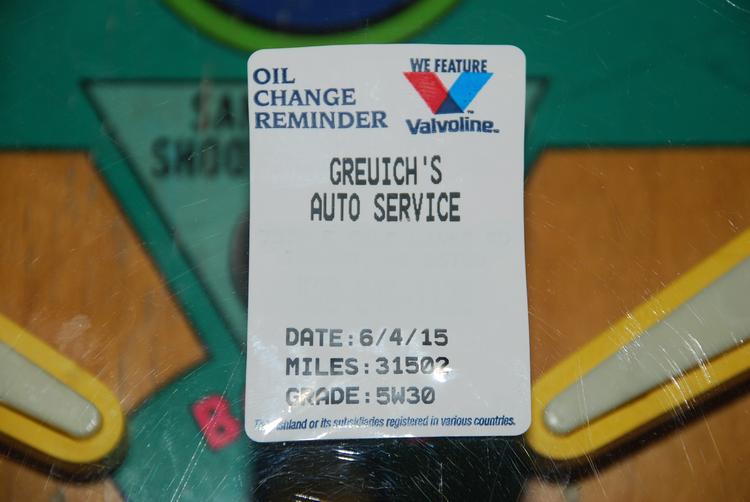
Do you remember those flexible oil change reminders that the automotive repair guy stuck to the inside of your windshield? Flexible nylon decals stick to smooth surfaces, are easily removed and can be used to provide the artwork on the plastic pieces. Or, if you prefer, waterslide decals can be used to provide the artwork instead of nylon decals.
Electronics – The PinPC
The game would be designed around a personal computer called a PinPC for easier maintenance and to minimize obsolescence. An LCD monitor would take up most, if not all of the backglass. The PinPC will supply all of the logic and most of the power requirements of the latest pinball machine designs. A second power supply will be required for the solenoid power.
Advantages:
- Replaces at a lower cost high voltage displays, MPU board, power supply board, driver board and sound board.
- Artwork on backglass no longer needed. Graphics are bits and bytes, not ink, and can be changed during the game.
- Common PC power supply voltages used plus 24 Volts or more for solenoids.
- USB support for all CPU controlled lights and CPU controlled solenoids.
- Plug and play PCIe cards for high definition displays, additional USB ports/hubs and for additional features not yet dreamed of or designed.
- Standardized USB 3.0, PCI Express 3.0, SATA 3.0, mSATA, DDR4 SDRAM reducing obsolescence.
- Onboard 7.1 channel sound.
- Flash memory/SSDs for game instructions and retained information.
- Inexpensive older generation dual core or quad core CPU for fast processing – powerful enough to process real-time streaming video.
- USB ports on pinball machine front door for mouse/keyboard/flash drive to customize, program and view game statistics.
- Easier to fix/repair/replace - larger pool of repairmen.
- Shorter down times.
- Easily customizable with standardized PC components.
- Tried and true technology.
- Allows designers to focus on the software and not the hardware – shorter lead times.
- Windows or Linux O/S.
Electronics – Capturing Scoring Events
A PinPC keeps track of the scoring. But how do you match the pinball location on the playfield with scoring opportunities? On most pinball machines this is done with physical switches. These are expensive and require wires to the CPU creating bundles of cables that rival the local copper wire telephone network. The PinPC will use an inexpensive video camera called a PinCam positioned above the playfield. The low resolution video will be transferred to the PinPC via WiFi, Bluetooth or USB. Real-time video tracking software running on the PinPC will determine where on the playfield a moving pinball is and when points will be scored. Any attempt to fool the scoring system will "Tilt" the machine, including any objects larger than a fly coming between the PinCam and the playfield.
Sound
Sound can be integrated with the PinPC software that identifies the position of the pinball to announce scoring events. “Call outs” can identify scoring opportunities for the deep ruleset. Speakers can be plugged directly into the PinPC sound ports. Sound quality will be enhanced with higher end speakers and sub-woofers.
Customization
As much as I like the nice shiny metal lock down bars so commonplace on pinball machines, I would prefer a lock down bar with buttons for options that a player could use to change how he or she wants the game to play. Personalized pinball is easy when the game is programmed to offer multiple options. Some options could be:
- "Music/No Music"
- "Easy" for newbs, "Harder" for casual players or "Full Blown Pinball Mayhem" for experienced players
- "Call outs - 1 -10", 1 being few and 10 being many
- "Guidance On/Off" for vocal help pointing to high value targets or special shots
Well, you get the idea. I won't go through a long list of options here. I leave that to you. Add your favorite option(s) in your feedback. Of course, a "Start" button should also be included on the lock down bar that can be pressed to bypass the options, if preferred, and start the game.
Playfield Control Hardware
I defer the design and type of hardware used to control the lights, solenoids and other playfield features to a future article if I decide to take this design to the next step. Ryan Claytor has pointed me toward the P-ROC board that can be used in a PC to control the pinball machine, though there are several functions of the P-ROC that I won’t be needing. If you will remember, the PinCam will track the real-time location of the pinball eliminating the need for playfield switches and a switch controller. A DMD controller and customization for WPC and Stern games isn’t needed either. Ideally, I would like to be able to use standard off-the-shelf components for the hardware and let the software control all of the unique features. The P-ROC board as it exists or a simplified version may become "the" standard for custom designed pinballs, and part of the “best” solution for my pinball project. As of the date of this writing, the P-ROC is unavailable – exactly the kind of issue I want to avoid. In addition to the P-ROC, I will be evaluating the FAST Pinball hardware and the SainSmart USB relay controller for possible use in the PinPC:
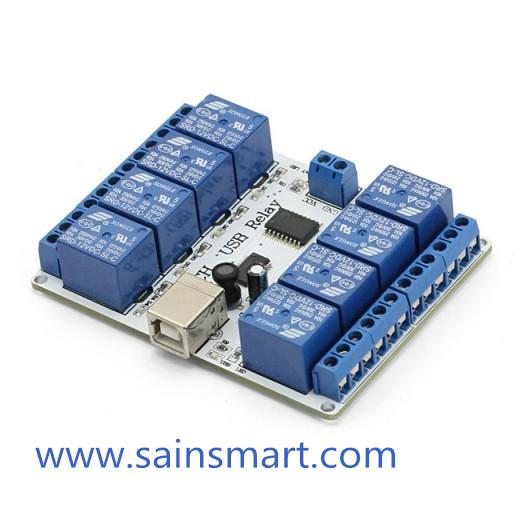
SainSmart 8-channel 12 V USB Relay Board Module Controller for Automation Robotics
Image courtesy of SainSmart: http://www.sainsmart.com/
The Future of Pinball
Taking this design to the next step, a PinServer and WIFI or Ethernet could be used to control multiple pinball machines. It wouldn't make sense for home use where there might be only one or two machines. However, for an arcade owner or a collector with more than five games,it could save a lot of money by replacing the PinPCs with a centralized PinServer.
The Bottom Line
I was going to send the design to Williams, but I don’t think I ever did. It would be fun to see a XOX machine. It would have a much more complicated ruleset than OXO with a simpler playfield than most of the modern monsters in order to keep costs low. This is where pinball manufacturers need to explore next. New games have become too expensive except for the lucky few who can afford them.
Gone are the expensive components of the traditional pinball design:
- Silkscreened playfield, backglass and plastics art
- Backglass and backglass back lighting
- Physical leaf or micro switches
- Wiring to playfield switches
- A lot of troublesome connectors
- High voltage backglass scoring, match and ball in play displays
- MPU, power, sound and driver boards
Kept are the components that makes pinball so special, a physical playfield with rubber rings, slingshots, pop bumpers, etc. and, of course, the pinball itself!
A fair amount of research and development will be required to get the first prototypes up and running. The beauty of this system is the minimal amount of expensive labor required to build production models. Targeted retail is $2995.00.
What do I call this concept pinball project? I call it the PinPin.
And Finally
Ryan Claytor of Elephant Eater Comics created this awesome XOX backglass for me. Thanks Ryan!
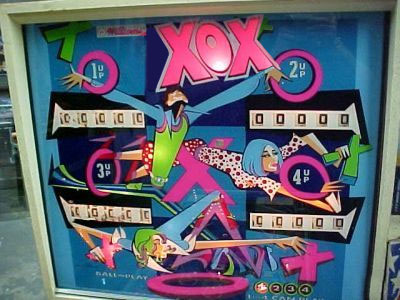
Williams 'XOX' backglass
Image created by Ryan Claytor
| Pecos SoftWareWorks Home | Contact Me | Terms of Use Rev 09/30/10 | Privacy Policy Rev 05/20/09 | About Us |
| Tweet |
|
||
|
© Copyright 2018 Alan Norton None of the content may be used or reproduced without written authorization from Alan Norton. |